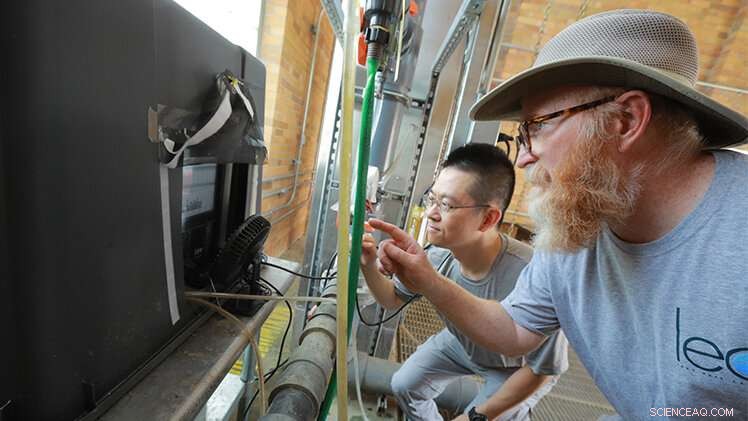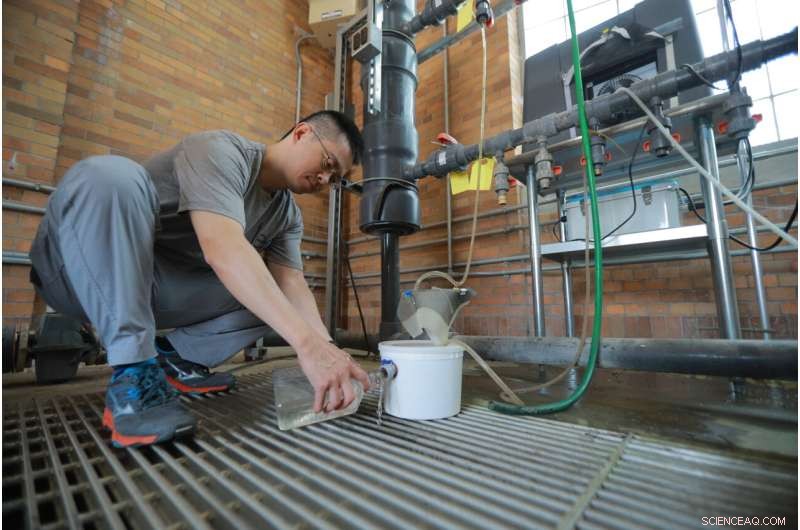
El Dr. Thomas Bridgeman, profesor de ecología y director del Centro UToledo Lake Erie, a la derecha, y el Dr. Kuo-Pei Tsai, investigador asociado postdoctoral, leen los datos provenientes del sistema de monitoreo de algas en línea que se está probando en el agua cruda de la ciudad. estación de bombeo para proteger el suministro público de agua potable durante la temporada de proliferación de algas nocivas. Crédito:Daniel Miller, Universidad de Toledo
A medida que el peligro se cierne sobre los cuerpos de agua en todo el mundo donde florecen algas tóxicas, una pequeña tina de almacenamiento de plástico en Toledo sellada para proteger contra salpicaduras, arañas y heces de pájaros puede contener una tecnología revolucionaria en la lucha contra el creciente problema ambiental.
Los científicos de algas de la Universidad de Toledo están probando un sensor óptico en tiempo real en la planta de tratamiento de agua de Toledo como parte de su monitoreo de agua de origen para proteger el suministro público de agua potable durante la temporada de proliferación de algas nocivas.
Cada 15 minutos, el dispositivo toma un sorbo del agua del lago Erie que ingresa a la planta, lee la muestra y pone los datos de medición en línea para que los investigadores y los administradores de servicios públicos de agua puedan acceder de forma remota.
Su mayor valor es la capacidad de determinar si los diminutos organismos unicelulares conocidos como cianobacterias que componen las floraciones de algas nocivas en el lago Erie son frágiles y comienzan a abrirse. Si las células se rompen, liberan toxinas. La toxina disuelta es más difícil de eliminar para las plantas de tratamiento de agua porque puede pasar a través de filtros y debe eliminarse por medios químicos antes de que el agua salga de la planta hacia nuestros grifos.
Desde julio, los científicos de UToledo han revisado los cables y los tubos del dispositivo para asegurarse de que funciona correctamente. También están haciendo experimentos de laboratorio en el Centro UToledo Lake Erie que muestran que la tecnología está funcionando de la manera esperada.
"Nuestro trabajo este verano con el dispositivo PhycoSens es la primera prueba de este sistema de monitoreo de algas en línea en una planta de agua potable en los EE. UU.", dijo el Dr. Thomas Bridgeman, profesor de ecología y director del Centro UToledo Lake Erie. "Si mostramos éxito en la planta de tratamiento de agua de Toledo y en toda la región para detectar y notificar de inmediato la liberación de toxinas, entonces se puede ampliar a nivel nacional. Hasta ahora, se muestra muy prometedor".
El despliegue de prueba del sistema de sensor de monitoreo avanzado es parte de un proyecto UToledo de $1.4 millones financiado por el Cuerpo de Ingenieros del Ejército de los EE. UU. que comenzó hace más de un año y se enfoca en la detección temprana y el manejo de la proliferación de algas nocivas.
Dado que la crisis del agua de Toledo de 2014 dejó a medio millón de residentes sin agua corriente segura durante tres días, los investigadores tienen más claro que no solo importa el tamaño y la apariencia de la proliferación de algas, sino lo que sucede en las células.
Los dispositivos de Bridgeman fabricados por la empresa alemana bbe Moldaenke utilizan sensores ópticos para medir en tiempo real cuántas y qué tipo de algas ingresan a la planta de tratamiento de agua, incluidas las cianobacterias. Más importante aún, los sensores pueden proporcionar una advertencia de que las células de cianobacterias se abren y filtran su contenido, incluidas las toxinas que puedan contener, en el agua.
"A large release of toxin can happen in a matter of hours, and it is critical for water plant operators to have this information so they can adjust their treatment levels quickly, before dissolved toxin can get through the plant," Bridgeman said. "The data are produced every few minutes, which makes it a useful early warning tool for a potentially rapidly changing algal situation."
Notable for researchers is data collected in late July showing the peak of the bloom and its decline.
"So far we have not detected any of that cell breakage at the water treatment plant or near the water intake out in the lake using the automated sensor, which is good news," Bridgeman said. "However, UToledo crews on our research vessel taking water samples out in the lake throughout Lake Erie's western basin—not near the water intake—have detected cell breakage using the manual version of the same device this season."
Bridgeman said that cell breakage events leading to large releases of dissolved toxin don't happen every year in Lake Erie.

Dr. Kuo-Pei Tsai, a post-doctoral research associate at the UToledo Lake Erie Center, works at the city's raw water pump station with the plastic storage tub containing a game-changing technology in the fight against toxic algae. Credit:Daniel Miller, The University of Toledo
"It happened in 2019 and possibly in 2014 but not to a large extent this summer, at least not near the water treatment plant's water intake out in the lake," Bridgeman said.
The Toledo Water Treatment Plant's laboratory makes the most use of the data.
"The experimental optical sensors being tested at the raw water pump station are a useful source for both the changes and the severity of algae levels coming from the lake," said Jeff Martin, chief chemist at the Toledo Water Treatment Plant. "We didn't have remote access to the data until part of the way through the bloom season due to computer issues, but since then it has been a welcome tool in treatment decisions."
Bridgeman has studied harmful algal blooms for two decades. His laboratory is one of the key locations for tracking and providing early warning of harmful algal blooms in the western basin of Lake Erie.
He said while the new instruments can detect the health, or physiological condition, of the cyanobacteria, they do not provide actual toxin readings, making them a supplemental weapon in a water utility manager's arsenal to efficiently and economically adjust treatment to maintain drinking water safety.
"Measuring toxin still requires a separate, fairly time-consuming test," Bridgeman said. "Therefore, the fast optical measurements will be coordinated with slower chemical toxin measurements to provide a complete picture of what is happening in the lake water that is entering the water plant."
The device will be removed from the water treatment plant for analysis in October and then his team will study the results and potentially put it back in the plant next summer.
Bridgeman's device monitoring tests are one part of a larger, wide-ranging project funded by the U.S. Army Corps of Engineers that also includes faculty in the UToledo College of Engineering.
Dr. Youngwoo Seo, professor of civil and environmental engineering and chemical engineering, leads the three-year project to improve water quality from the source to the tap.
Some of the technology and techniques being tested by UToledo are new to water treatment plants in the western hemisphere.
The project features two different parts working together:
Dr. Dae-Wook Kang, assistant professor of civil and environmental engineering, leads a molecular approach to develop a robust detection method, and his analysis will help better understand what triggers the toxin gene production of cyanobacteria.
Seo is focused on mitigation and the treatment method for toxin removal. His laboratory is working on the biological degradation of cyanobacteria and their toxins using the naturally occurring bacteria and viruses from the lake and NSF-approved chemical treatments. Harmful algal bloom becomes detectable along western Lake Erie